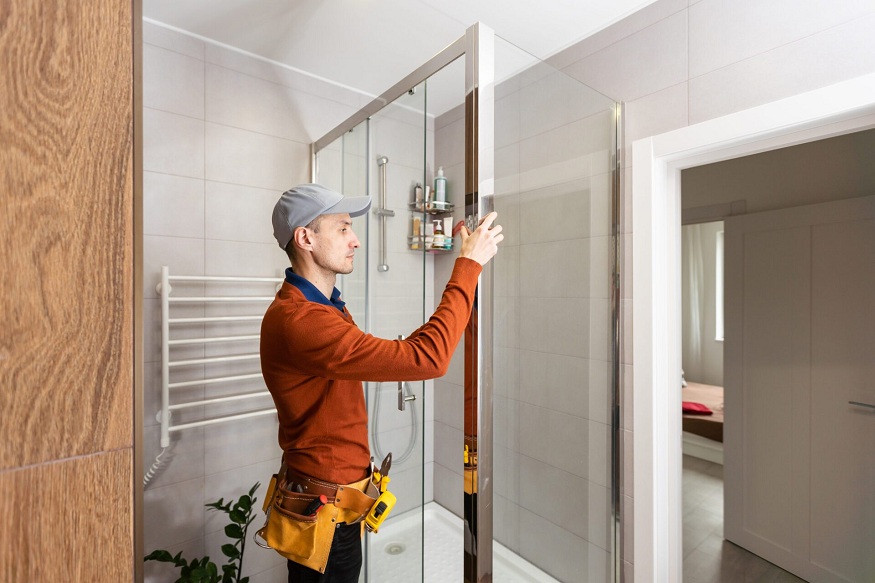Picture this: you’ve finally decided to upgrade your bathroom, and one of the most impactful changes on your list is installing a brand-new, stylish shower door. It’s a wonderful way to give your bathroom a fresh look and make your daily shower experience more luxurious. But now comes the big question – should you take the DIY shower door installation route or hire a professional to handle the installation?
Here, we’ll walk you through a step-by-step comparison of DIY vs. professional shower door installation. While both options have their merits, we’re going to show you why it usually makes sense to lean toward the professional route and explain why it’s often the superior choice for most projects.
First, however, let’s break down the professional vs. DIY shower door installation process and the steps involved.
Step-by-Step Guide to Professional Shower Door Installation
Hiring a professional for your shower door installation ensures a smooth and worry-free experience.
Here’s a general overview of what you can expect.
Step 1: Consultation and Measurement
A professional installer will assess your bathroom’s layout and specific needs. They will take precise measurements to ensure a perfect fit for your shower door.
Step 2: Product Selection
Based on your preferences and budget, the installer will help you choose the right type and style of the shower door (for example, framed, frameless, or semi-frameless). They can offer guidance on materials, finishes, and features.
Step 3: Ordering Materials
The installer will order all the necessary materials, including the shower door, hardware, and additional components.
Step 4: Preparation
Before the installation begins, the installer will prepare the area by ensuring the walls and floor are level and free from any obstructions. They will also protect the surrounding surfaces to prevent damage.
Step 5: Installation
The professional will carefully install the shower door, ensuring it’s level, plumb, and secure. They will precisely follow the manufacturer’s instructions to guarantee a watertight and functional result.
Step 6: Sealing and Testing
After installation, the installer will apply waterproof sealant to all necessary joints and seams. They will also test the door for proper operation and ensure no leaks.
Step 7: Cleanup
Your installer will clean up the workspace, remove debris, and leave your bathroom spotless.
Step 8: Warranty
Most professional shower door installers offer a warranty on their work. If any issues arise, they will return to address them within the specified warranty period without an added cost to you.
Step-by-Step Guide to DIY Shower Door Installation
If you’ve decided to install your shower door yourself, here’s a step-by-step guide to help you navigate the process. Please keep in mind this is just a general overview, and there are more details and instructions you’ll need to follow based on the specific shower door model and manufacturer’s instructions.
Step 1: Gather Tools and Materials
Before you start, make sure you have all the necessary tools and materials, including:
- The shower door kit
- Drill
- Level
- Measuring tape
- Silicone sealant
- Safety gear
Step 2: Measurement and Planning
Measure your shower area carefully to determine the exact dimensions of your door. Plan the installation, considering factors like hinge placement and door swing direction.
Step 3: Prepare the Area
Clear the shower area of obstructions and ensure the walls and floor are level. You may need to make adjustments if they are not.
Step 4: Install Frame (if applicable)
Follow the manufacturer’s instructions to install the door frame if your shower door kit includes one.
Step 5: Attach Hinges and Handles
Install the hinges and handles according to the manufacturer’s guidelines. Ensure they are level and secure.
Step 6: Hang the Door
Carefully hang the shower door on the hinges, ensuring it swings smoothly and closes just right.
Step 7: Seal the Edges
Apply silicone sealant to the edges and joints of the door to prevent water leakage. Allow it to dry as per the manufacturer’s instructions.
Step 8: Test the Door
Test the door carefully. Make sure it opens, closes, and seals properly. Look for any leaks or gaps.
Step 9: Cleanup
Clean up the shower door installation area and dispose of any debris properly.
Step 10: Maintenance
Regularly inspect your DIY-installed shower door for any signs of wear or leaks. Be prepared to make adjustments or repairs as needed.
DIY Shower Door Installation Pros
- Cost-Savings: One of the main reasons people opt for a DIY installation is to save money. You won’t have to pay for labor costs, which can be a significant portion of the overall budget.
- Sense of Accomplishment: Some people find that finishing a DIY project successfully is incredibly rewarding. It gives you a sense of accomplishment and pride in your handiwork.
- Flexibility: DIY allows you to work on your own schedule, so you can take your time and adjust as needed.
Cons of DIY Shower Door Installation
- Skill and Experience: Installing a shower door is more complex than it might seem. You need specific tools and a good understanding of the installation process. A mistake could result in leaks, uneven installation, or even shattered glass.
- Time-Consuming: DIY projects can take longer than expected, especially if you’re new to this type of work. It might disrupt your daily routine for a while.
- No Warranty: If something goes wrong with your DIY installation, you won’t have the safety net of a professional warranty to fall back on.
Professional Shower Door Installation Pros
- Expertise: When you hire a professional, you’re tapping into their expertise. They have the knowledge and experience to handle any challenges during installation.
- Efficiency: Professionals are skilled at completing installations efficiently. They’ll get the job done quickly and accurately, minimizing any inconvenience.
- Warranty: Most professional installers offer warranties on their work. This provides peace of mind, knowing any issues will be addressed without additional cost.
Cons of Professional Shower Door Installation
- Cost: Hiring a professional does come at a price—you’ll need to pay for their labor and expertise (but this tends to pay off big time).
Summary: Why Professional Shower Door Installation is the Way to Go
At first glance, DIY shower door installation might seem appealing for cost-conscious individuals, but the potential risks and challenges should not be underestimated. In most cases, going the professional route is the smarter choice.
Professionals, like those at Coastal Closets and Showers in Stuart, bring a level of skill, efficiency, and reliability that’s hard to match with a DIY approach. Not to mention, the peace of mind with a warranty is invaluable, ensuring your new shower door remains a source of joy rather than frustration.
So, if you’re considering a shower door installation project, carefully weigh the pros and cons. It’s often worth the investment to hire a professional and ensure a beautiful, hassle-free result you can enjoy for years.

